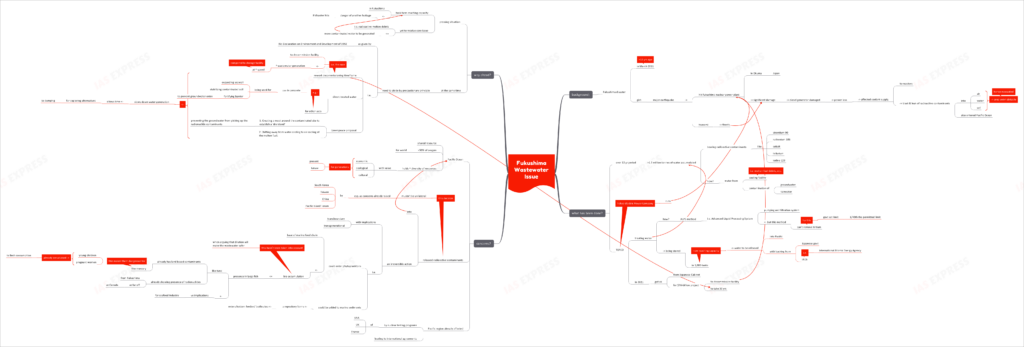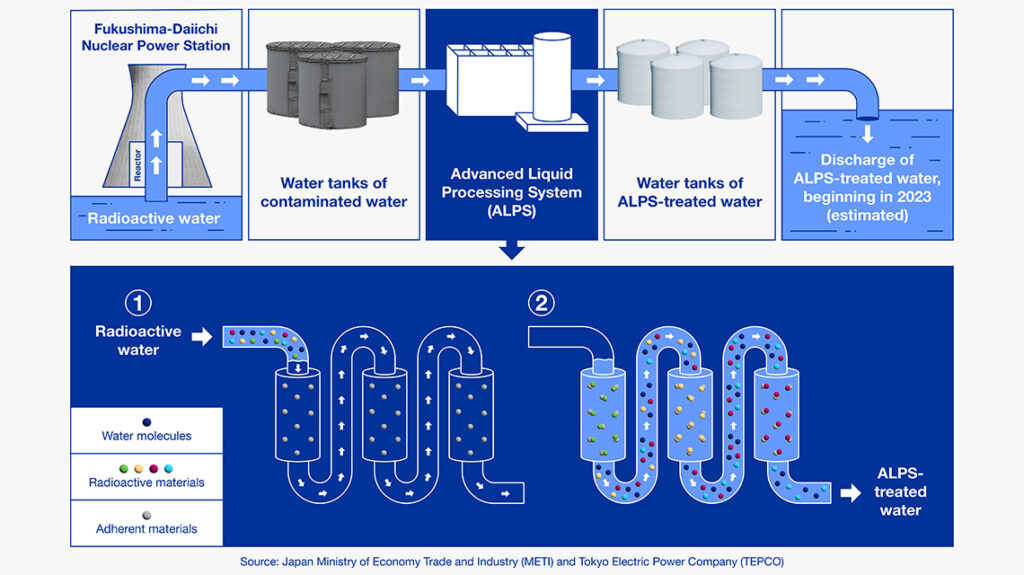Fukushima Wastewater Issue- Measures, Concerns & Alternatives

This year, over a million tonnes of wastewater from Japan’s Fukushima nuclear power plant is set to be released into the Pacific Ocean. However, the country is taking flak from various quarters over this controversial decision which could have potentially negative consequences.

Background:
- In March 2011, a major earthquake hit Okuma’s Fukushima Daiichi nuclear power plant, causing significant damage.
- A subsequent tsunami flooded the plant, damaging its diesel generators and causing a loss of power.
- The loss of power affected the coolant supply to reactors and the tsunami disabled the backup systems. Note that nuclear power plants require constant supply of cooling water.
- Radioactive materials leaked from reactor pressure vessels and entered the ambient air, water and soil. It also affected the local population, making the power plant and its surrounding land uninhabitable.
- Winds carried radioactive material into the Pacific Ocean too.
What has been done?
- In 2021, TEPCO (Tokyo Electric Power Company), the entity that operates the plant, got the Japanese Cabinet approval for a $76-billion project to decommission the plant. This undertaking is expected to take 3 decades for completion.
- Meanwhile, over 1.3 million tonnes of water, bearing radionuclide contaminants (like strontium 90, ruthenium 106, cobalt, tellurium and iodine 129), have accumulated on site, over the past 12 years. This comes from water used to cool the reactors, ground water and rainwater.
- TEPCO has been treating the water to remove most of the radioactive contaminants. The ALPS (Advanced Liquid Processing System), a pumping and filtration system- was used for this purpose.
- While the ALPS is incapable of removing tritium contaminants, the Japanese government required the treated water to limit the tritium concentration to 1/40th the permitted limit.
- The treated water is being stored in some 1,000 tanks at the site. The storage in these tanks are now reaching full capacity.
- This year, TEPCO is set to start releasing the water into the Pacific Ocean, with the approval of the Japanese government and the International Atomic Energy Agency.

What are the concerns?
- The Pacific Ocean is a shared resource that provides over 50% of the world’s oxygen and a diversity of resources, holding economic, ecological and cultural value for present and future generations.
- The release of radioactive wastewater into the Pacific is an irreversible action with transboundary and transgenerational implications. This should not be unilaterally undertaken by any country. For instance, concerns have been raised by South Korea, Taiwan, China and the Pacific Islands Forum.
- Phytoplankton, the base for all marine food webs, can capture and accumulate a variety of radioactive elements found in the Fukushima cooling water, including tritium and carbon-14.
- Once contaminants are in the cells of marine organisms, they do not break down and accumulate in a variety of invertebrates, fish, marine mammals, and humans. Marine sediments can also be a repository for radionuclides and provide a means of transfer to bottom-feeding organisms.
- The assumptions that underpin the modelling of concentrations and ocean circulation may not be correct. This ignores the biological uptake and accumulation in marine organisms and the associated concern of transfer to people eating affected seafood.
- Tuna and other large ocean fish already contain mercury from land-based sources, which requires people, especially pregnant women and young children, to limit their consumption. Similarly, tuna have also been found to contain radionuclides from Fukushima. Such radioactive contaminant-bearing tuna were found as far off as Canada.
- The Pacific region and its people have already suffered from the devastation caused by nuclear testing programs- by the USA, UK and France, and international agreements have been made to curtail such testing.
What is the way ahead?
- After over a decade of the Fukushima disaster, the wastewater issue continues to endanger the region. As the storage in the 1,000-odd tanks reach full capacity, there is a concern that another disaster could trigger a major leak again. Meanwhile, the core issue of the radioactive molten fuel debris is yet to be resolved- meaning more radioactive waste water generation.
- At the same time, there is a need to abide by the precautionary principle enshrined in the Rio Declaration on Environment and Development of 1992.
- In pursuance of this principle, there is a need to rework decommissioning timeframe. For instance, the race to decommission the facility is leading to wastewater generation at a faster rate than the storage facilities could keep up.
- Another way is to use the treated water to mix concrete that is currently being used to expand the seawall, stabilize the contaminated soil and fortify the barrier to prevent groundwater inflow.
- A proposal from Greenpeace suggested some measures:
- Creating a moat around the contaminated site to establish a ‘dry island’, preventing the groundwater from picking up the radionuclide contaminants.
- Shifting away from water cooling to air cooling of the molten fuel.
- These measures would slow down the water accumulation. Meanwhile, technological alternatives to dumping could be explored.
Conclusion:
The current rush to treat, dilute and dump the treated water must be postponed in view of the serious implication for the entire region’s people and environment. This must be done until due diligence is performed and alternative technologies are seriously considered.
Practice Question for Mains:
Comment on the pros and cons of Japan dumping its Fukushima plant water into the Pacific Ocean. What is the way ahead? (250 words)
If you like this post, please share your feedback in the comments section below so that we will upload more posts like this.

